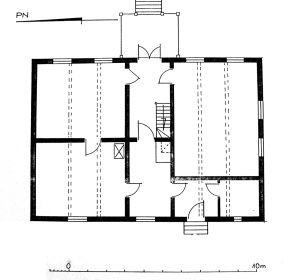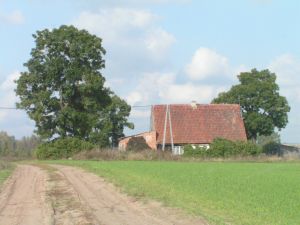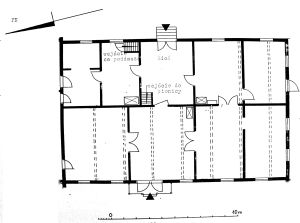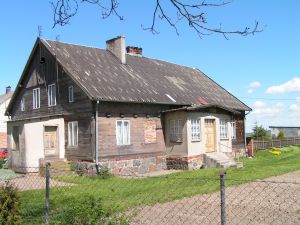|
gm. Warlubie, pow. świecki, woj. kujawsko-pomorskie

In the village there was a cemetery of box graves. During the reign of the Teutonic order the settlement belonged to Pokrzywin komturia then to the Grudziądz and Świecie komturias.
In the second half of the 16th century as the royal property it was part of the Nowe poviat. In the seventies the Dutch settled here. In 1588 a tenancy contract for 30 years was issued. In 1604 a contract was issued for 50 years. Peasants were allowed to use other villages' mills and brew beer for their own needs. The village owned 11 measured włókas, 12 morgas, 90 pręts. All Dutch villages on this side of the Vistula paid also for permission to use other villages' mills for their home needs in the period when they could not cross the Vistula. In 1624 the village owned a parcel of land called Łężnica. In 1739 the inhabitants received the right for 40 years from the chancellor's wife, Szembekowa. The village owned then 9 włókas, 42 morgas, 90 pręts. The second right of chancellor Szembek the village received in 1724 for three włókas for 40 years. The third right from commissioner Blar from 1719 for 50 years. Fourth right to free taking of beer and grist, for Unraw farmer, from chancellor's wife in 1733 for 40 years. Farmers were also free to sell grains and other goods, and were exempted from forced labour.
In the Prussian partition the village entered into the Świecie powiat of the Kwidzyn District, belonging to the Bzowo Catholic parish and the Górna Grupa Evangelic parish. In the village there was an Evangelic school. In the 19th century it possessed 1311.71 morgas, 33 buildings, 18 houses, 150 inhabitants (34 Catholics, 76 Evangelists). In the western part of the village was a cemetery. A linear village situated in the north-eastern part of the Świecie poviat. The main road runs along the northeast-south line.
In the village there are four wooden houses related to the Olęder colonisation.
  No. 2 - house built in the fourth quarter of the 19th century, with its ridge facing the main road running through the village; situated in its south-western part, not connected with farm buildings. The homestead has a dispersed layout. The building was used as a school. Before the war it belonged to a German named Roose.
No. 2 - house built in the fourth quarter of the 19th century, with its ridge facing the main road running through the village; situated in its south-western part, not connected with farm buildings. The homestead has a dispersed layout. The building was used as a school. Before the war it belonged to a German named Roose.
The building is on the plan of a rectangle, double-bay with a hallway in the eastern bay. In the hallway axis, in the western part, a kitchen is located. Entrance doors in the eastern and western elevations. Single-floor, with a cellar under part of it. Covered with a double-pitched roof. The loft is usable. The northern elevation is single-axial, symmetrical. The southern elevation is bi-axial, unsymmetrical. The eastern elevation is five-axial, symmetrical. The western elevation is four-axial, unsymmetrical.
The house rests on a brick and stone plinth, is made of wood and has a corner-notched structure. Brick, bottle-shaped chimney. Wooden floors. Ceilings made of ceiling joists with bevelled edges. The gables are planked. Collar beam roof truss. Roof covered with metal sheeting. One-frame, plastic windows. Wooden, single- and double-leaved doors having a frame and panel structure. Wooden, straight-flight, quarter landing staircase.
Documents on which the study was based: Osiek 2, Historic Monuments of Architecture and Construction Registry Card, elaborated by I. Jastrzębska-Puzowska, E. Sekuła-Teuer, K. Bartkowski, typescript, Bydgoszcz 1993; Osadnictwo holenderskie Doliny Wisły w województwie bydgoskim, typescript, Bydgoszcz 1992/1993, part 3, No. 27; Zabytki architektury i budownictwa w Polsce. Województwo Bydgoskie, elaborated by K. Parucka vol. 5, Warszawa 1997, part 2, p. 460.
 No. 3 - house built on the turn of the third and fourth quarter of the 19th century, with its gable facing a dirt road running parralel to a road leading to Komórsk; located in the north-western part of the village, housing the farm and residential sections lined-up under one roof.
No. 3 - house built on the turn of the third and fourth quarter of the 19th century, with its gable facing a dirt road running parralel to a road leading to Komórsk; located in the north-western part of the village, housing the farm and residential sections lined-up under one roof.
The building is inacessible. Single-floor, covered with a double-pitched roof. The northern elevation connected with the farm section. The southern elevation is single-axial, symmetrical. The eastern elevation is four-axial, unsymmetrical. The southern elevation is five-axial, unsymmetrical.
The house rests on a brick and stone plinth, is made of wood and has a corner-notched structure. The farm section is made of brick. The roof is covered with pantiles. One-frame, plastic windows. Wooden, single-leaf doors having frame and panel structure.
  No. 5 - house built in the third quarter of the 19th century, with its ridge facing a road running through the village; located in its north-eastern part, housing the farm and residential section lined-up under one roof. Before the war the farm belonged to Johan Jans.
No. 5 - house built in the third quarter of the 19th century, with its ridge facing a road running through the village; located in its north-eastern part, housing the farm and residential section lined-up under one roof. Before the war the farm belonged to Johan Jans.
The building is on the plan of a rectangle, double-bay with a hallway in the eastern bay. Kitchen in the south-eastern part. Entrance door in the southern, western and western elevations. Single-floor with mansard roofs in the roof surface, with a cellar under part of it. Covered with a double-pitched roof. The loft has a residential and usable character. The northern elevation connected with the farm section. The southern elevation is four-axial, symmetrical. The eastern elevation is five-axial, unsymmetrical. The western elevation is six-axial, unsymmetrical.
The house rests on a brick and stone plinth, is made of wood and has a corner-notched structure. The farm section is made of brick. Brick, simple chimney. Wooden floors. Ceilings made of ceiling joists with bevelled edges. The gables are planked. Collar beam roof truss with king posts. Roof covered with ceramic tiles. Wooden, double-cased, two-level windows in window-frames. Wooden, single- and double-leaf doors having a frame and panel structure. Simple wooden straight-flight staircase.
Documents on which the study was based: Zabytki architektury województwa bydgoskiego, eds. M. E. G±siorowscy, Bydgoszcz 1974, p. 229; Katalog zabytków sztuki w Polsce, vol. XI, Dawne województwo bydgoskie, eds. vol. Chrzanowski, M. Kornecki, z. 15: Powiat ¶wiecki, elaborated by vol. Chrzanowski i vol. Żurkowska, Warszawa 1977, p. 31; Osiek 5, Historic Monuments of Architecture and Construction Registry Card, elaborated by I. Jastrzębska-Puzowska, E. Sekuła-Tauer, K. Bartowski, typescript, Bydgoszcz 1993; Osadnictwo holenderskie Doliny Wisły w województwie bydgoskim, typescript, Bydgoszcz 1992/1993, part 3, No. 28; Zabytki architektury i budownictwa w Polsce. Województwo Bydgoskie, elaborated by K. Parucka vol. 5, Warszawa 1997, part 2, p. 287.
 No. 11 - house built in the fourth quarter of the 19th century, with its gable facing road running through the village; located in its north-eastern part, not connected with farm buildings. The homestead has a dispersed layout.
No. 11 - house built in the fourth quarter of the 19th century, with its gable facing road running through the village; located in its north-eastern part, not connected with farm buildings. The homestead has a dispersed layout.
The building is inacessible. Entrance doors in all elevations. Single-floor with a pointing sill. Covered with a double-pitched roof. The northern elevation is tri-axial, unsymmetrical, with a porch covered by a double-pitched roof. The southern elevation is four-axial, unsymmetrical with a porch covered by a double-pitched roof. The eastern elevation is bi-axial, unsymmetrical. The western elevation is four-axial, unsymmetrical with a porch having a pent roof.
The house rests on a brick and stone plinth, wooden, with a pointing sill having corner-notched structure. The gables are planked. The roof is covered with asbestos cement. One-frame, plastic windows. Wooden, single-leaf doors having frame and panel structure.
Documents on which the study was based:: Zabytki architektury i budownictwa w Polsce. Województwo Bydgoskie, elaborated by K. Parucka vol. 5, Warszawa 1997, part 2, p. 461.
Słownik geograficzny Królestwa Polskiego i innych krajów słowiańskich, red. B. Chlebowskiego, W. Walewskiego, t. 7, Warszawa 1886, s. 632; H. Maercker, Eine polnische Starostei und ein preussischer Landrathkreis. Geschichte des Schwetzer Kreises 1466-1873, "Zeitschrift des Westpreussischen Geschichtvereins", H. 17-19, Danzig 1886-1888, s. 226; Opis królewszczyzn w województwach chełmińskim, pomorskim i malborskim w roku 1664, wyd. J. Paczkowski, TNT, Fontes 32, Toruń 1938, s. 81; Lustracja województw Prus Królewskich 1624 z fragmentami lustracji 1615, wyd. S. Hoszkowski, Gdańsk 1967, s. 46, 265-66; K. Ciesielska,, Osadnictwo "olęderskie" w Prusach Królewskich na Kujawach w świetle kontraktów osadniczych, "Studia i Materiały z dziejów Wielkopolski i Pomorza", t. 4, 1958, s. 223; Inwentarz starostwa grudziądzkiego z roku 1603 oraz rejestr dochodów z lat 1601-1603, wyd. S. Cackowski, Grudziądz 1965, s. 29; Katalog zabytków architektury i budownictwa w Polsce, z. 2, M. Arszyński, M. Rejmanowski, Województwo bydgoskie,(Biblioteka Muzealnictwa i Ochrony Zabytków, Seria A, t. VII, Warszawa 1972, s. 61; Katalog zabytków architektury i budownictwa w Polsce, z. 2, M. Arszyński, M. Rejmanowski, Województwo bydgoskie,(Biblioteka Muzealnictwa i Ochrony Zabytków, Seria A, t. VII, Warszawa 1972, s. 59; Zabytki architektury województwa bydgoskiego, red. M. E. Gąsiorowscy, Bydgoszcz 1974, s. 229; Katalog zabytków sztuki w Polsce, T.XI, Dawne województwo bydgoskie, red. T. Chrzanowski, M. Kornecki, z. 15: Powiat świecki, oprac. T. Chrzanowski i T. Żurkowska, Warszawa 1977, s. 31; Mikulski K., Osadnictwo wiejskie woj. Pomorskiego od poł XVI do końca XVII wieku, Rocznik TNT, R. 86, Toruń 1994, z. 2, s. 166; P. J. Klassen, Ojczyzna dla przybyszów, Wprowadzenie do historii mennonitów w Polsce i Prusach, Warszawa 2002, s. 42.Słownik geograficzny Królestwa Polskiego i innych krajów słowiańskich, red. B. Chlebowskiego, W. Walewskiego, t. 7, Warszawa 1886, s. 632; H. Maercker, Eine polnische Starostei und ein preussischer Landrathkreis. Geschichte des Schwetzer Kreises 1466-1873, "Zeitschrift des Westpreussischen Geschichtvereins", H. 17-19, Danzig 1886-1888, s. 226; Opis królewszczyzn w województwach chełmińskim, pomorskim i malborskim w roku 1664, wyd. J. Paczkowski, TNT, Fontes 32, Toruń 1938, s. 81; Lustracja województw Prus Królewskich 1624 z fragmentami lustracji 1615, wyd. S. Hoszkowski, Gdańsk 1967, s. 46, 265-66; K. Ciesielska,, Osadnictwo "olęderskie" w Prusach Królewskich na Kujawach w świetle kontraktów osadniczych, "Studia i Materiały z dziejów Wielkopolski i Pomorza", t. 4, 1958, s. 223; Inwentarz starostwa grudziądzkiego z roku 1603 oraz rejestr dochodów z lat 1601-1603, wyd. S. Cackowski, Grudziądz 1965, s. 29; Katalog zabytków architektury i budownictwa w Polsce, z. 2, M. Arszyński, M. Rejmanowski, Województwo bydgoskie,(Biblioteka Muzealnictwa i Ochrony Zabytków, Seria A, t. VII, Warszawa 1972, s. 61; Katalog zabytków architektury i budownictwa w Polsce, z. 2, M. Arszyński, M. Rejmanowski, Województwo bydgoskie,(Biblioteka Muzealnictwa i Ochrony Zabytków, Seria A, t. VII, Warszawa 1972, s. 59; Zabytki architektury województwa bydgoskiego, red. M. E. Gąsiorowscy, Bydgoszcz 1974, s. 229; Katalog zabytków sztuki w Polsce, T.XI, Dawne województwo bydgoskie, red. T. Chrzanowski, M. Kornecki, z. 15: Powiat świecki, oprac. T. Chrzanowski i T. Żurkowska, Warszawa 1977, s. 31; Mikulski K., Osadnictwo wiejskie woj. Pomorskiego od poł XVI do końca XVII wieku, Rocznik TNT, R. 86, Toruń 1994, z. 2, s. 166; P. J. Klassen, Ojczyzna dla przybyszów, Wprowadzenie do historii mennonitów w Polsce i Prusach, Warszawa 2002, s. 42.
|


 No. 2 - house built in the fourth quarter of the 19th century, with its ridge facing the main road running through the village; situated in its south-western part, not connected with farm buildings. The homestead has a dispersed layout. The building was used as a school. Before the war it belonged to a German named Roose.
No. 2 - house built in the fourth quarter of the 19th century, with its ridge facing the main road running through the village; situated in its south-western part, not connected with farm buildings. The homestead has a dispersed layout. The building was used as a school. Before the war it belonged to a German named Roose. No. 3 - house built on the turn of the third and fourth quarter of the 19th century, with its gable facing a dirt road running parralel to a road leading to Komórsk; located in the north-western part of the village, housing the farm and residential sections lined-up under one roof.
No. 3 - house built on the turn of the third and fourth quarter of the 19th century, with its gable facing a dirt road running parralel to a road leading to Komórsk; located in the north-western part of the village, housing the farm and residential sections lined-up under one roof.
 No. 5 - house built in the third quarter of the 19th century, with its ridge facing a road running through the village; located in its north-eastern part, housing the farm and residential section lined-up under one roof. Before the war the farm belonged to Johan Jans.
No. 5 - house built in the third quarter of the 19th century, with its ridge facing a road running through the village; located in its north-eastern part, housing the farm and residential section lined-up under one roof. Before the war the farm belonged to Johan Jans. No. 11 - house built in the fourth quarter of the 19th century, with its gable facing road running through the village; located in its north-eastern part, not connected with farm buildings. The homestead has a dispersed layout.
No. 11 - house built in the fourth quarter of the 19th century, with its gable facing road running through the village; located in its north-eastern part, not connected with farm buildings. The homestead has a dispersed layout.